As I write, the radio is wittering on about possible snow storms, and raindrops are skittering across my study’s skylight, a glum, grey rectangle above my head. It’s a good time to look back at some summer photos from the garden.
2016 was the year of the late start for me, it took a while for me to get a move on. I was convalescing from an operation until March, with plenty of time to order seeds but not enough energy to sow them. Even once I was well enough to go back to work I was definitely lacking in the spare oomph department. No steady, rolling start to spring for me – suddenly in a steaming hurry, I sowed far too many seeds at the same time in April before going to Scotland (see my Arisaig post) and found myself with a glut of young plants in early May.
Here in the Cotswolds it isn’t really safe to plant out tender plant babies until the end of May, so while the outside world was burgeoning with tulips, blossom and gardeny get-togethers, there was a growing air of desperation in my greenhouse and tiny polytunnel.
Then in mid May I abandoned everything and spent about a week in London for Chelsea (see my posts about Chelsea Flower Show). By the time I returned everything was in agony, and as it was also summer bedding time at work I was spending more time there too. I began to dread getting invitations to go out and be sociable at weekends because the plants were screaming for my attention. I had managed to get the dahlias out and hardened off before Chelsea but everything else was hopping about in a long queue, bursting to get into a bigger pot.
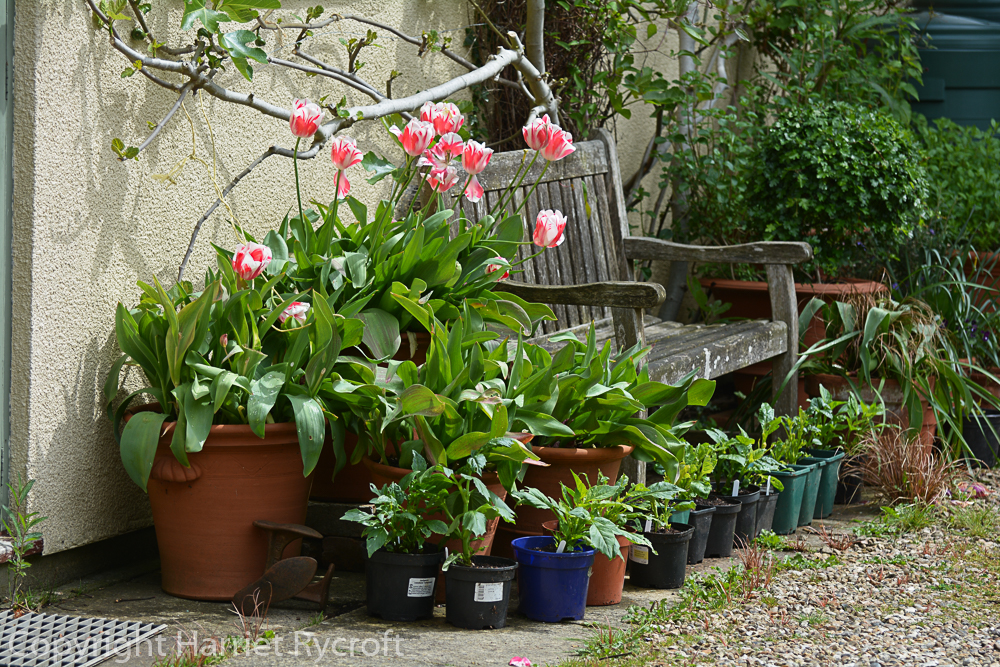
Dahlias lined up outside the garage and under the bench to grow on among the last of the tulips in May
In my little world of pots there is no room for new plants until other plants and obstacles have been moved on, so the whole exercise becomes a giant game of solitaire. In order to win I have to think very hard about the order in which I make my moves. This is roughly how it went last year:
Move 1: The bench beside the garage got shifted to the lawn (hiding the bald patch created by the Eranthis hyemalis which had been and gorn). Pots with borderline hardy perennials,which had been fleeced instead of emptied, and pushed against the sheltered, sunny garage wall, were cut back and tidied, any corpses went to the compost heap and the survivors were top dressed.
Move 2: The first tentative plant shifting took place at the end of May, with the hardier semi-permanent potfuls emerging from garage and greenhouse on dull, mild days to stand, blinking, in temporary homes against the garage wall. Bit by bit they began to replace the winter plantings that were past their best. (see Move 3)

Early June, the Echium & hardier salvias have had their fleece off for a while, a few petunias and Cerinthe plants have been planted around them. Agapanthus etc have been brought out and tucked between them to harden off. The bench has been put out to grass.
Move 3: Early-Mid June. Some of the winter plantings which still looked good were either left in situ or moved to a display I built up by the kitchen door, where there’s a shady little patio area (with whirligig clothes line, compost bucket, chairs, tap, hose and miscellaneous gubbins..). Single potted plants including a Liquidambar styraciflua, Ginkgo biloba ‘Troll’, a blueberry, various hydrangeas and Francoa ramosa, were moved here too and I had great fun playing with foliage colour, form and texture. In some ways this was the area I liked best that summer, though there were very few flowers involved.
Shame hardly anybody saw it – that door is mainly used by the cat. She didn’t appreciate the pots at all because the nasty moggy from across the road took to ambushing her from behind them every time she emerged from the cat flap.

Fun with foliage. The plant in the centre is Impatiens omeiana. My vine weevils like it as much as I do.
Move 4: Mid-Late June. Having moved or emptied most of the winter pots by the back door I proceeded to fill them up again. In the rain. It’s at this stage that you must never, ever ask yourself, “Why am I doing this?”
I also moved some big plastic tubs into this area. It’s the biggest bank of pots each year, so the plastic tubs get hidden quite quickly. This year I had decided on pastel pink/white/blue/purple, diluted with grey foliage and enlivened with a few stronger shades.

Mid July. Filling out. A few changes have been made, for example an Agapanthus which failed to flower has been replaced by a pot of Roscoea purpurea ‘Vincent’

Late July. Beginning to get a bit congested. I have cut the yellow flowers off the Helichrysum ‘White Barn’ (grey leaves, front left) because they were annoying me.

Early August. I have removed two large pots of Echiums and the Pinus ‘Fat Albert’ but you’d never know it because everything else has filled out so much.

Mid August. Persicaria orientalis (back right) has shot up, white Dahlia ‘My Love’ in the centre is struggling to keep its head above the foliage
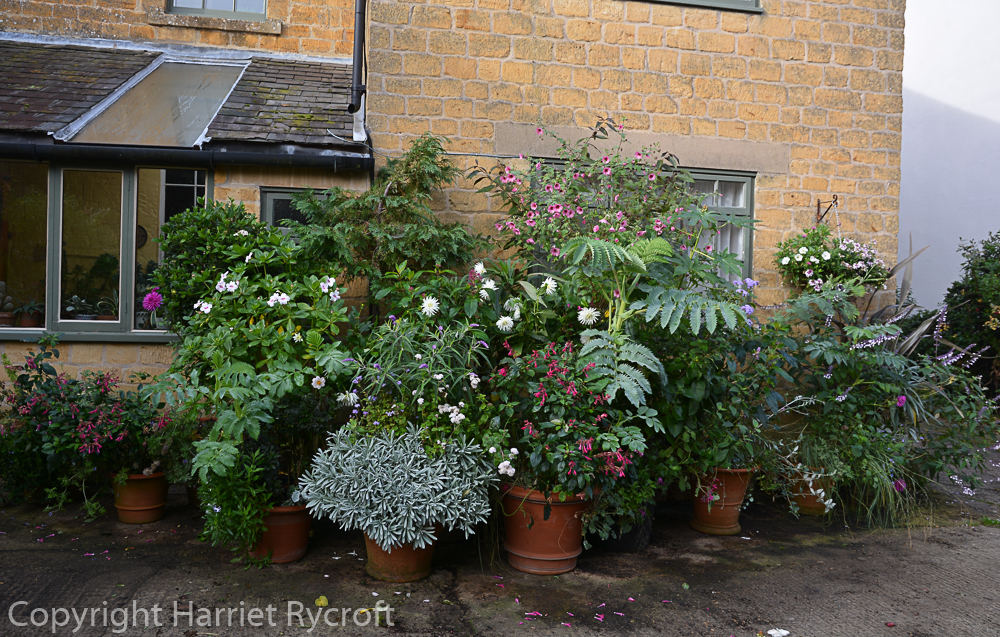
Last day of October, I have started to take smaller pots into shelter, precious plants have been dug out and/or propagated
Throughout June plants were still pouring out of the greenhouse and polytunnel like porridge from the Magic Porridge Pot. There were also loose but re-usable grasses and perennials from the winter pots knocking about. So between the major Moves as listed, there were many sub-moves, involving potting-on of overwintered tender plants which deserved a pot to themselves, and potting up of evicted hardy perennials. Most of this happened under the big yew tree – which also happens to be a good, shady, sheltered hardening-off area.
Under the yew tree is where quite a lot of tripping over and swearing happens.
The yew tree also hosts slug fiestas: in 2016, as never before, I had a massive plague of Spanish slugs (Arion vulgaris). Sadly they had not brought any sherry with them. They had spent the mild winter making merry and babies. I did water nematodes over badly sluggy areas during a mild, damp week in June, which gave me a little respite, but they came back eventually. I should have given another dose but I ran out of time. Spanish slugs are massive, unashamedly greedy, disgustingly sticky (therefore good climbers) and orange. Which public figure springs to mind? We have frogs, toads and hedgehogs but they don’t seem to touch these ghastly gastropods.
I got into the habit of feeling under every single pot and plant tray (oh they LOVE those!) that I picked up, removing slugs and stamping on the smaller ones. The big ones are too rubbery to squash easily, you can actually slip over if you step on them. So I put handfuls of big ones into the green waste bin. I got less and less squeamish about this as the summer went on.
Move 5: After the major planting by the back door was done I emptied/replaced tired seasonal pots outside the kitchen window, having top-dressed the semi-permanent ones. This is also north-facing so usually relies on foliage, especially ferns, with a few splodges of colour from shade-tolerating incomers such as Fuchsia and Begonia.
This year I went (with some misgivings) for yellow and pink , with some blue, because the pink rambling rose (‘Débutante’) has grown all the way along this wall now, and there was quite a lot of pink in the pots the other side of the back door. I was never really happy with it. I had a couple of screaming pink pelargoniums (they look rather red in the photos) which I eventually moved away and never really found a good place for them. Also several of the plants were better suited to a sunnier site, so flowered late and somewhat sparsely – that’s the trouble with prioritising colour over habitat. I make mistakes like that every year, but sometimes I get away with it.

Amicia zygomeris creeping up the kitchen window. I enjoyed watching its odd leaves fold up in the evening.

Back door in mid August. Bit of a gloomy day but you get the general idea. Nasty Pelargonium has been replaced with a slightly less lurid one.

Salvia curviflora outside the kitchen in mid October. Wonderful colour in shade, but it might have flowered a bit earlier in sun.
Move 5.5: All the little fiddly touches: small pots get squeezed in at the front of the displays, with some placed on top of other pots where gaps haven’t been closed yet by growing plants.
Move 6: Late-ish June. While planting up the back door pots I also set up big pots and distributed major plants by the garage and “car park”. I had plans for reds, blacks and some purple/blue by the garage. These areas involved quite a few dahlias and salvias which had been growing on in plastic pots, so the displays looked established pretty quickly (slugs permitting).

Mid August. After this photo we went away for a couple of weeks and I should have staked the dahlias more firmly because when we got back everything was sagging outwards a bit too much.

Early September. That purple dahlia was supposed to be black ‘Verrone’s Obsidian’. I bought it in a garden centre because it wasn’t available from my usual supplier – should have realised it was a risk, I suppose. I was cross at first and then decided I didn’t mind it.

End of October, the big Salvia elegans (pineapple sage) has got going just in time. The foliage really does smell of pineapple.
Move 7: Late June to early July. As the number of homeless plants goes down, so the planting speed increases. The garage pots and car park pots were all planted by early July. The car park was going to be the only place where I could fit my various Musa/Canna/Ensete, I teamed them with orange, bronze, yellow and a little black and red.
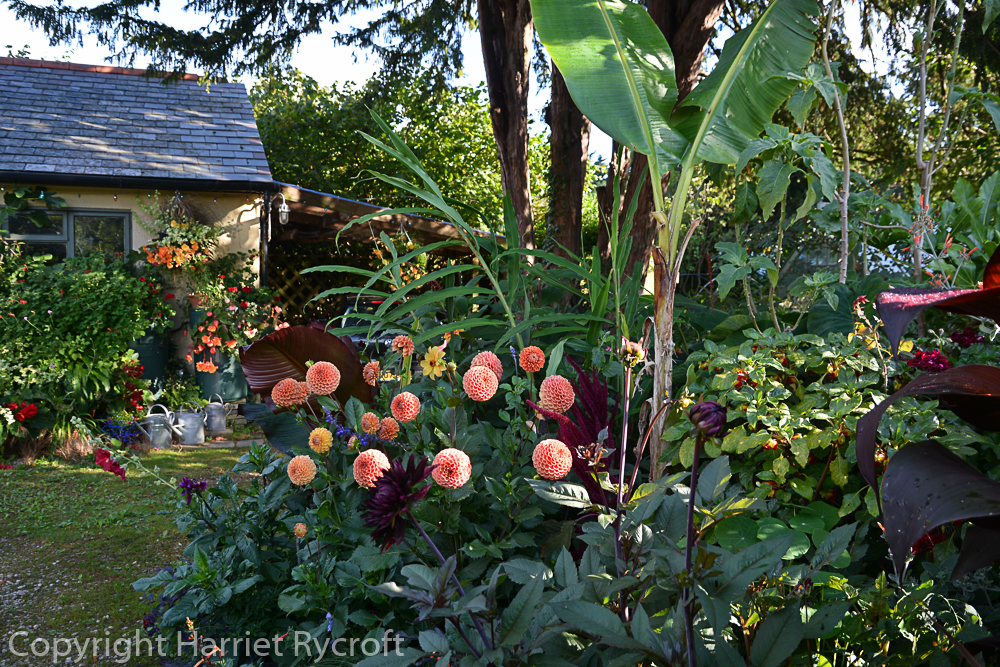
Early Sept. The pompom Dahlia in the centre is ‘Cornel Brons’ from Peter Nyssen, it was a real star.
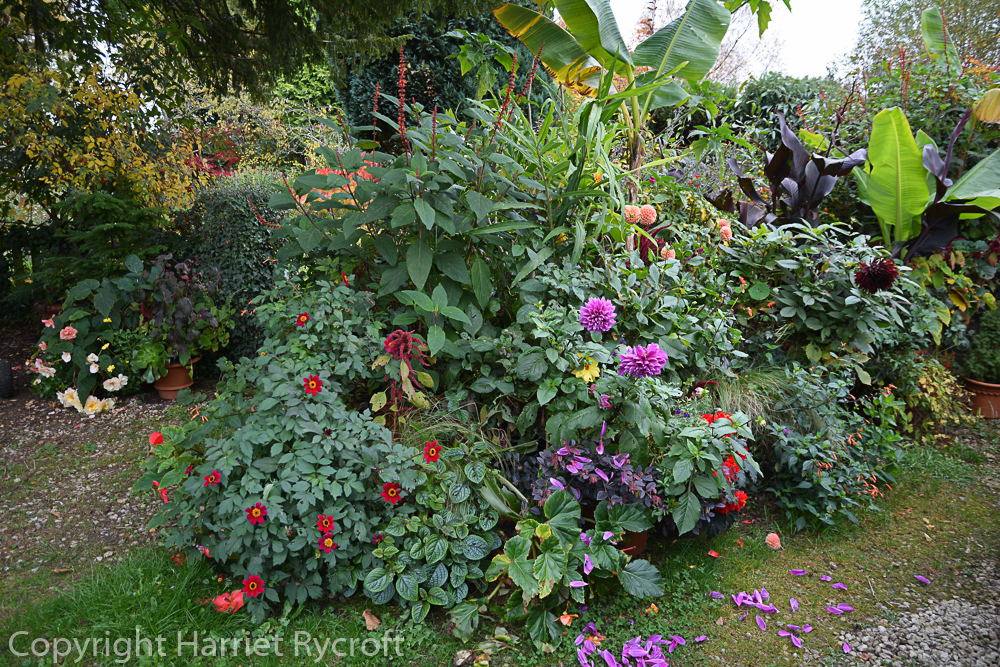
End of October. Another rogue purple dahlia collapses. The dark red single Dahlia on the left is ‘Bishop of Auckland’

Last day of October. Tropaeolum tuberosum ‘Ken Aslet’ had only just started to flower, but too late! Frost was forecast and I wanted to save the Musa sikkimensis and Salvia confertiflora it was climbing up, so it all got dismantled the next day.
Move 8: By the second week of July I was ready to clear out the area under the yew tree and set up a display of odds and ends left over from the other groups, which turned out to be mostly coral and salmon, with some red and dashes of yellow and white. It’s always those peachy colours which get left over with me, I can never decide what to do with them. Perhaps in 2017 I’ll start with those.
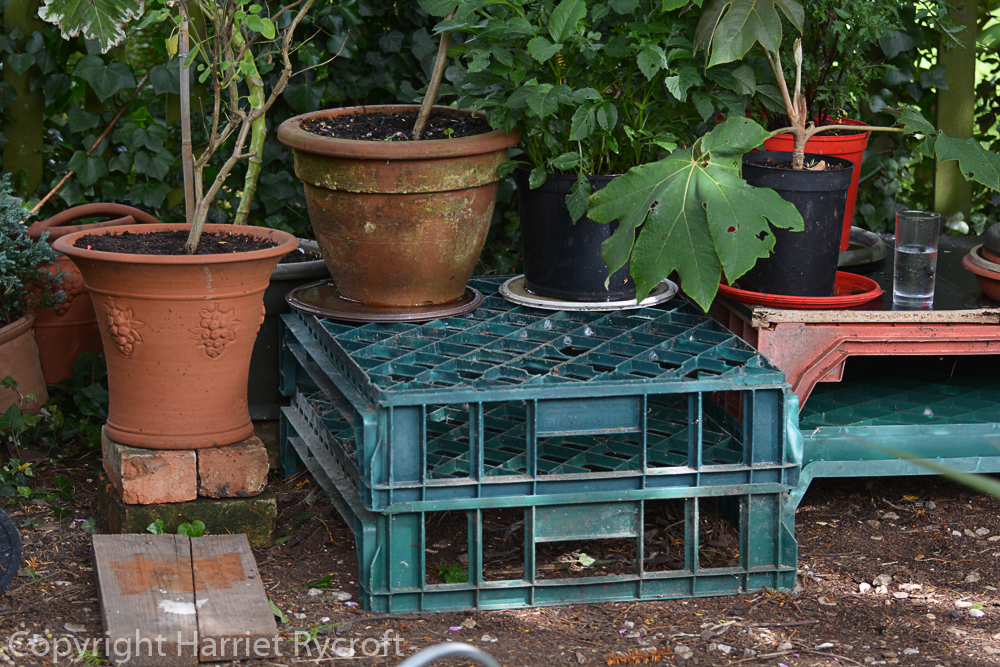
Mid July. Arranging the last few plants under the yew tree. I use anything I can lay my hands on to make platforms so that I can fit more pots in…
Move 9 covers the many sub-moves and substitutions of the summer, moving away plants which have been shredded by slugs or which have got too big or too boring for their positions. Moving and re-moving annoying plants which don’t sit happily with their neighbours, moving in new purchases (surreptitiously). I bought a few glazed pots in a sale and played with those too.

Every now and then I have to make adjustments to a display. Here some of those wretched super-slugs had got into the dahlias, so I had to pull some plants out and have a good slug hunt and tidy up. I *may* have squeezed in a couple of new plants too.
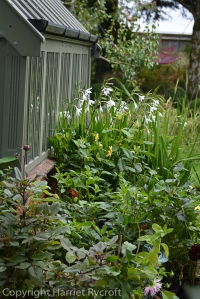
Spare dahlias and Gladiolus murielae waiting by the greenhouse. Tallish plants in plastic pots are very useful gap-pluggers.
I had spare dahlias and potfuls of Gladiolus murielae growing by the greenhouse and inserted them in displays where gaps appeared. This works very well, as the plastic pots are easily hidden behind established plantings. The trick is to remember where they are so that they don’t get missed at watering time. Sometimes I put these pots on shallow saucers or bucket lids so that they get as much water as possible.
By the end of the summer I think I had approximately 300 pots on display, and as usual it was very hard to manoeuvre vehicles. Or get through doors. Or see out of windows. If our yard was smart and nicely-paved I might think that less is more, but cracked old concrete and scruffy gravel needs as much covering as possible.
I’m sorry if the weeds around the pots offend any of you, but I’m not prepared to use weedkiller on something so unimportant. Occasionally I use a weed blowtorch to zap weeds which are going to seed, and I do pull some of the big ones out, but otherwise I tolerate them and occasionally my tolerance is rewarded by a nice self-seeded Echium or Verbena.
People often ask about the watering of all these pots, but I am careful to apply RP3 – Right Plant,Right Pot, Right Place – as much as possible. This and close-grouping means that I should not have to water every single day, even in hot weather. Over the summer of 2016 we went away several times, for anything from a few days to a fortnight in each month, and each time our 20 year-old son, with zero interest in gardening, managed to keep everything alive. Only my rather half-hearted hanging baskets suffered at these times.
When you go away during the summer there is always the optional Move 10, which consists of putting easily stressed plants into shadier, more sheltered positions before you go. Reducing the amount of foliage in the pots also helps them to survive water shortages better while your offspring/neighbour/cat is in charge.
Container gardening is great because you CAN move your plantings if you’re not content with the effect, but I try to do so as little as possible for the sake of my back, planting as many of my pots as I can in the location where they’ll stay for at least a few months. My last moving tip of the day is to invest in a sack trolley, preferably with as large a footplate as possible and a concave back to keep pots steady. I use one for moving all but the very smallest pots, even when they are empty.
The final move involved dismantling all the plantings and sheltering all my precious tender plants or taking cuttings from them. This was a year when the frosts started early in November, so at Hallowe’en I had to admit that summer was over.
Now I’m going to move on and look at seed catalogues for 2017 so that I can start all over again.

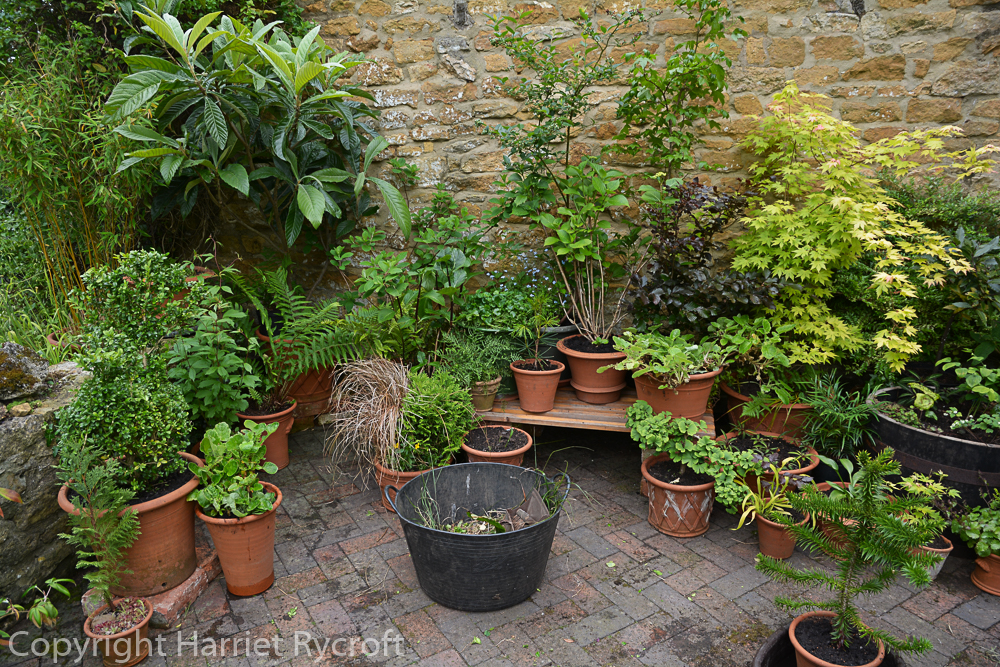

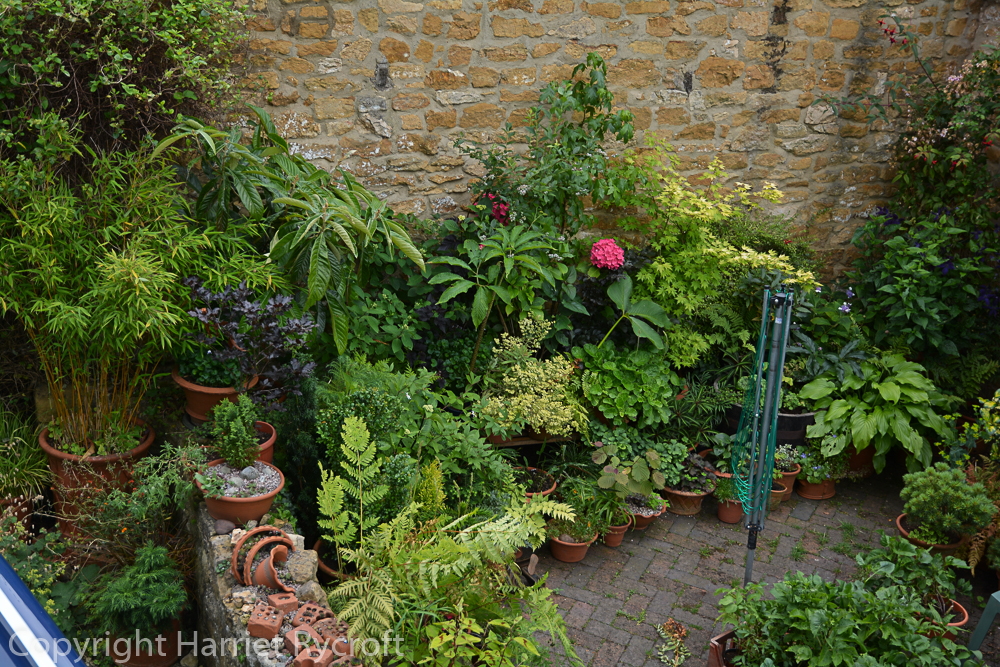




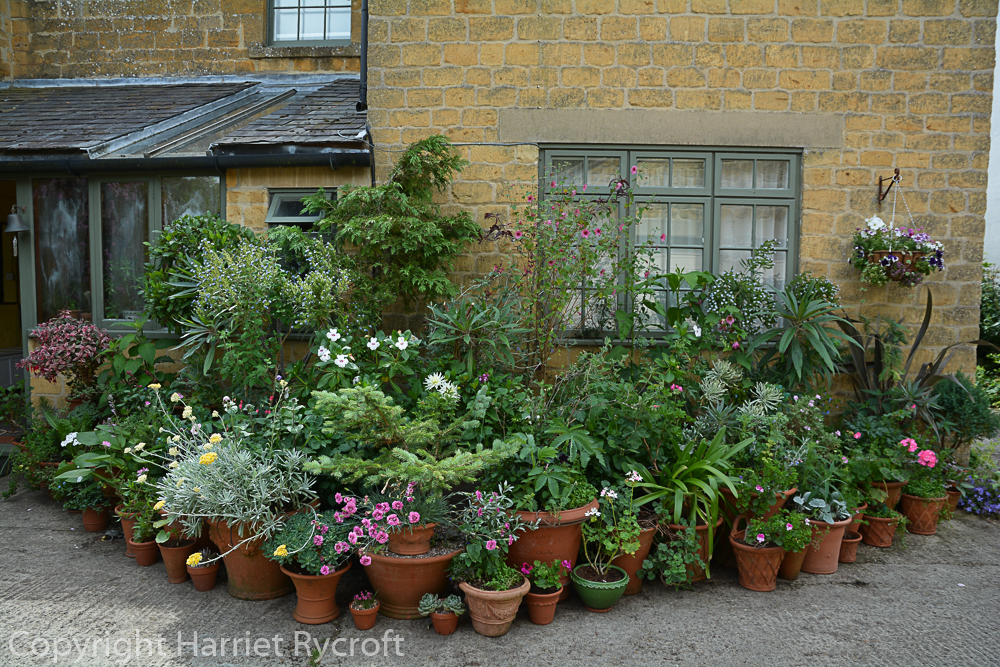

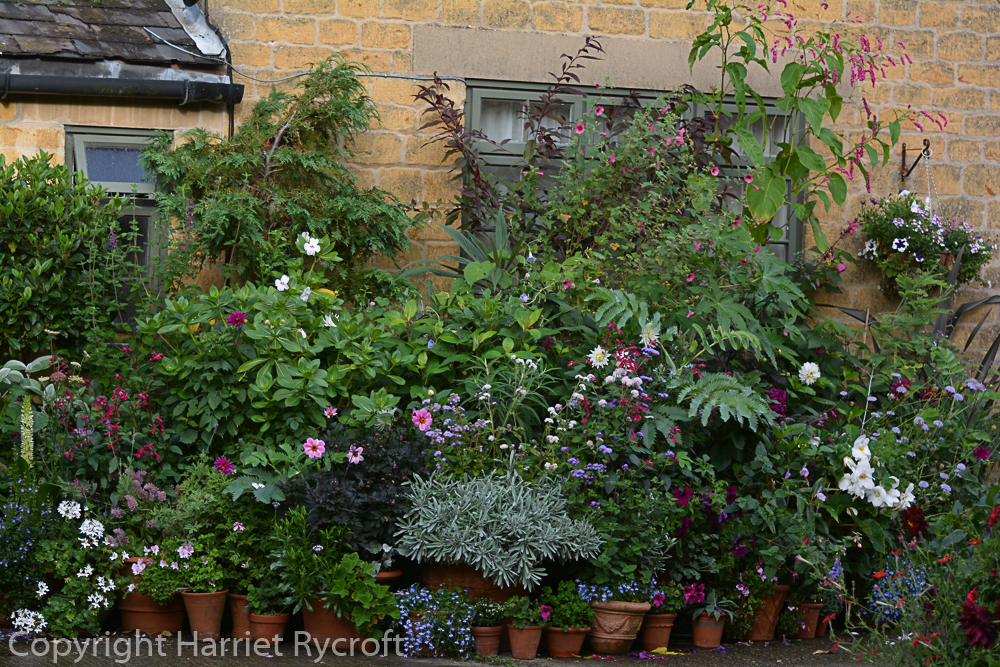










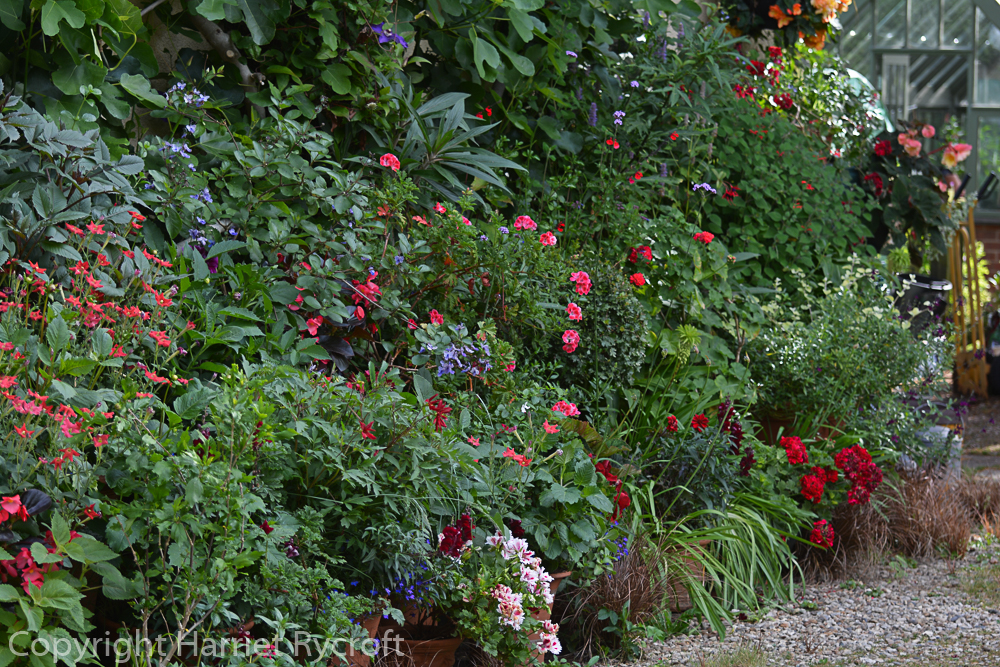








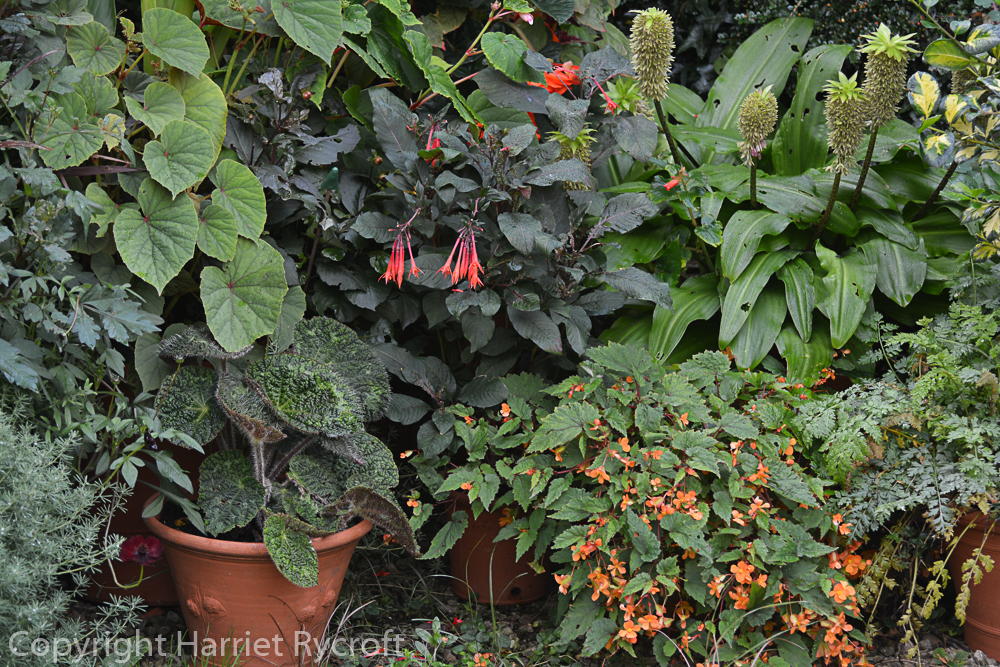
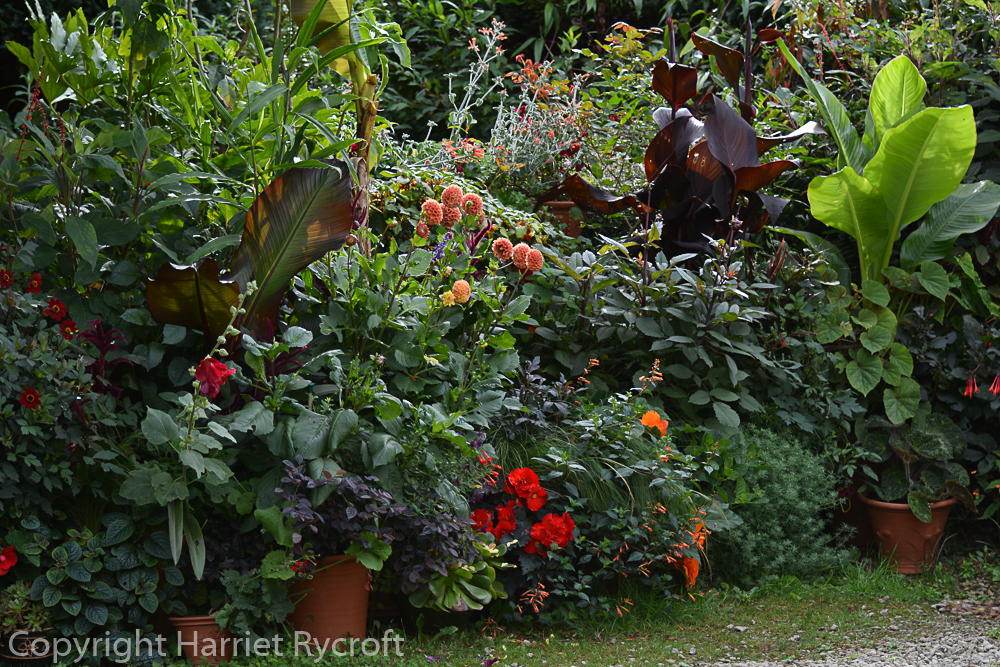

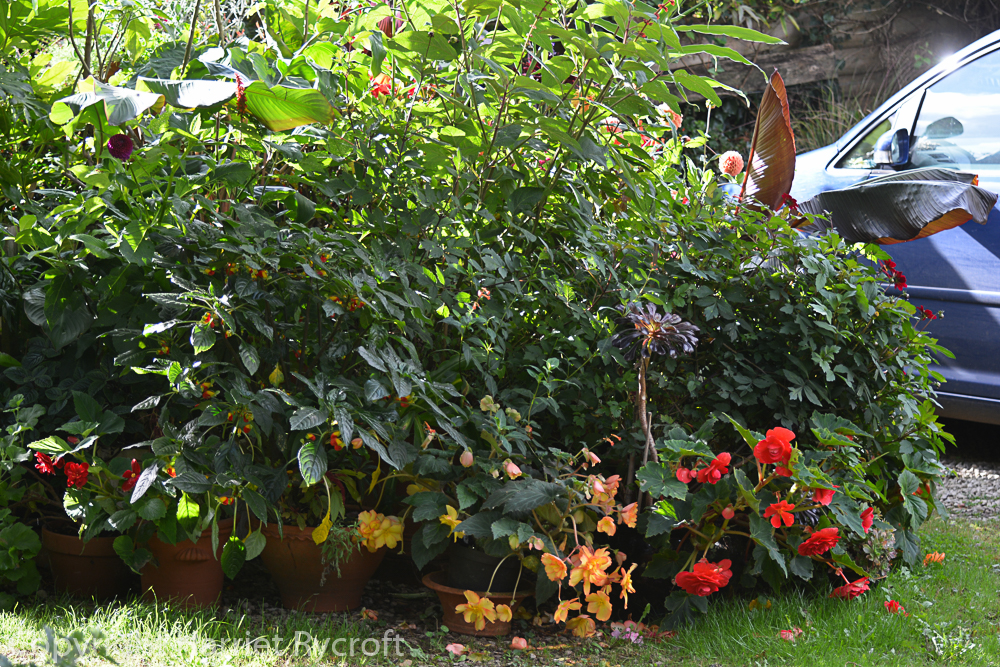


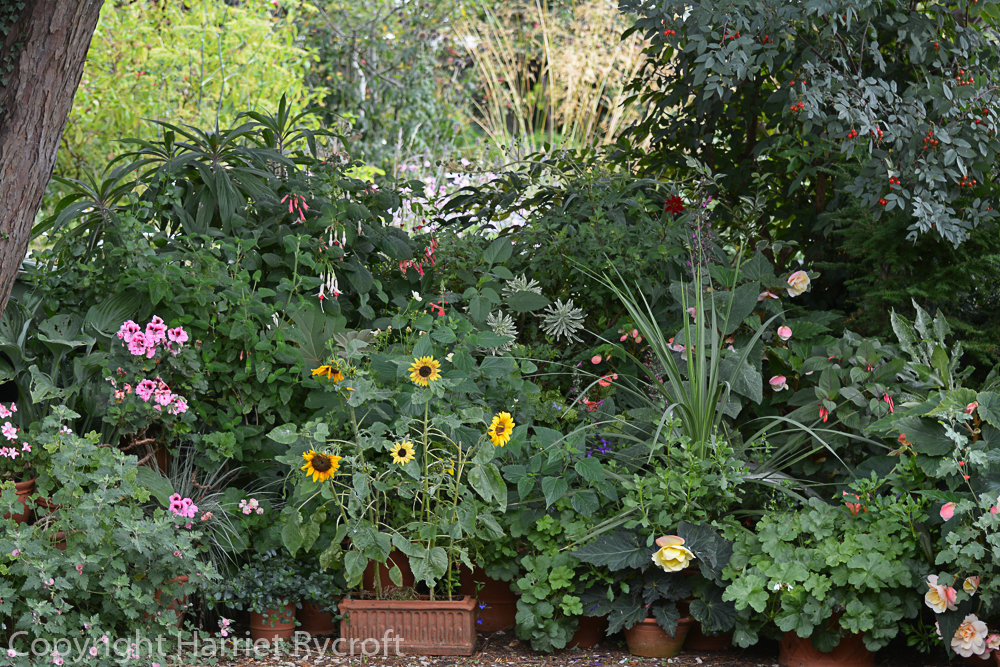







Wonderful and inspiring – I had a bit of a pot lightbulb moment last year as I finally realised how I could group pots to soften areas. In the past i have always thought about pots on their own maybe with a selection of plants but then they lack the impact I want. How big a pot do you use for dahlias? Did you see the Small garden Big Dreams episode last week which featured your old employer and a lady who could only have pots – was lovely.
LikeLike
Thanks Helen. Yes, groups are the way to go. I often say it makes the pots look like they are MEANT to be there rather than having just been absentmindedly plonked down. Of course I am an absentminded plonker too!! Pot size depends on the dahlia variety and whether you are planting other things with it, also how sheltered the position. As a rule of thumb I would want a pot at least 30cm/12″ deep for a 1m/3ft dahlia to be happy all summer. They are quite greedy and def sulk if water-stressed. Yes I saw SGBD (on catch-up because people alerted me to it) and it made me shout at the telly a bit, especially when Monty spilled compost on the nice new gravel not once but twice! But I thought a lot of the advice was really good and the end result was delightful (although if some of those plants don’t die she’ll have nowhere left to sit soon!). A warmhearted programme, I thought, and I felt so sorry for the lady who was missing her garden so badly.
LikeLike
I’m exhausted after reading that account! Not sure if I would have survived actually doing it all. Well done you! Now you just need to get rid of the car and build a wall across the entrance to the driveway. Or put those seed catalogues down 🙂
LikeLike
Ha! Thanks John, bonkers really. The rest of my garden has to look after itself, pretty much! I won’t say I’m not tempted to ban cars – but we live on a road where the competition for parking is pretty fierce. Still haven’t really got going on the seed catalogues – first I need to check what’s left over from last year..
LikeLike
Just wonderful! You are not known as the Container Queen for nothing! I’ve really enjoyed mooching through your garden for the past hour. All fired up now for spring. My children will have to park on the grass!!!! All the best, karen at karengimson.wordpress.com
LikeLike
Thanks Karen, rumours of my connections to the/any royal family are totally without foundation! Oh yes, I’m aching for spring, especially with the vile weather we’ve had this weekend. Gotta keep looking forward!
LikeLiked by 1 person
Crikey Harriet, such an impressive display and such dedication! I can only think of the watering and feeding, ..as you know I have a particular interest in this myself. Congratulations it looks fantastic.. How did the pot bug begin?
Sarah X
Sarah Wain
>
LikeLike
Thanks Sarah, that means a lot coming from you! I first started growing things in pots nearly 30 years ago when we had our first home – a garden flat in London, then when we moved to a house in Oxfordshire the front steps and porch somehow filled with potted plants. Then of course I went to work at Whichford and the habit got really bad – by the time we moved to our current house (15 years ago) I needed two estate-car-loads, 1 landrover and a horsebox to move just the flowerpots! I don’t know what I’ll do if we move house again…
LikeLike
Absolutely loved your blog on containers. I’ve recently moved to a small garden and will replace the lawn with plants. At the front I have two walkways about six foot wide where I intend to have containers so the response to Helen Johnstone’s question was very useful. I found your blog via Hardy Plant Society’s booklet Cornucopia which reprinted Julieanne Porter’s article on Garden Blogging.
Many thanks for the inspirational photos and information.
LikeLike
Thank you Sue! It’s funny how many roundabout ways there are of finding interesting blogs. Sounds like your garden will be one to watch!
LikeLike